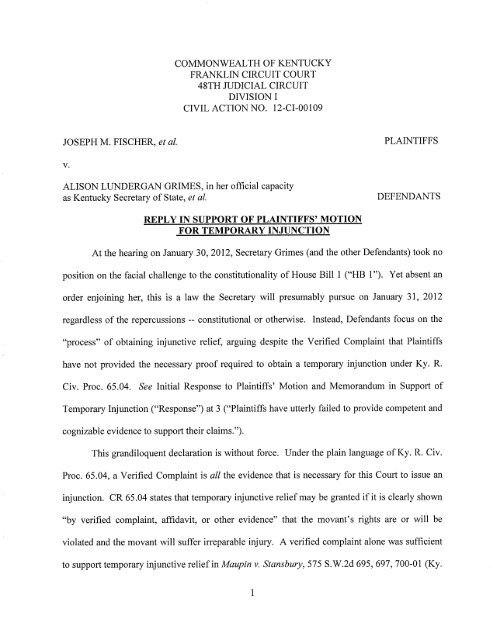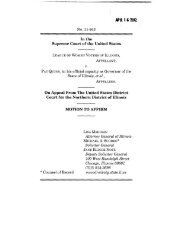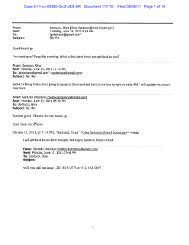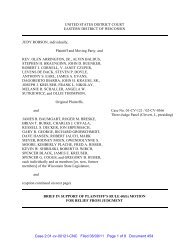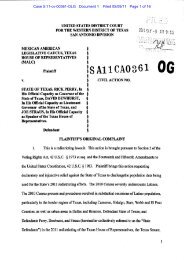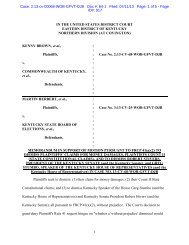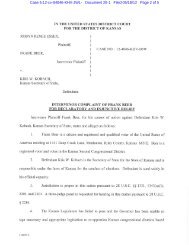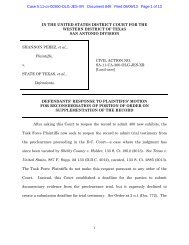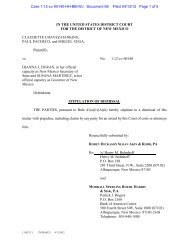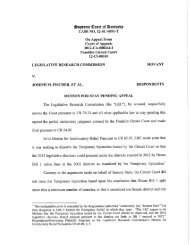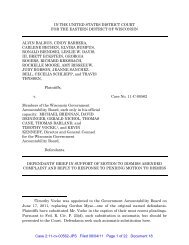Reply - About Redistricting
Reply - About Redistricting
Reply - About Redistricting
Create successful ePaper yourself
Turn your PDF publications into a flip-book with our unique Google optimized e-Paper software.
COMMONWEALTH OF KENTUCKY<br />
FRANKLIN CIRCUIT COURT<br />
48TH JUDICIAL CIRCUIT<br />
DIVISION I<br />
CIVIL ACTION NO. 12-CI-00109<br />
JOSEPH M. FISCHER, et al.<br />
PLAINTIFFS<br />
V.<br />
ALISON LUNDERGAN GRIMES, in her official capacity<br />
as Kentucky Secretary of State, et al.<br />
DEFENDANTS<br />
REPLY IN SUPPORT OF PLAINTIFFS’ MOTION<br />
FOR TEMPORARY INJUNCTION<br />
At the hearing on January 30, 2012, Secretary Grimes (and the other Defendants) took no<br />
position on the facial challenge to the constitutionality of House Bill 1 ("HB I"). Yet absent an<br />
order enjoining her, this is a law the Secretary will presumably pursue on January 31, 2012<br />
regardless of the repercussions -- constitutional or otherwise. Instead, Defendants focus on the<br />
"process" of obtaining injunctive relief, arguing despite the Verified Complaint that Plaintiffs<br />
have not provided the necessary proof required to obtain a temporary injunction under Ky. R.<br />
Civ. Proc. 65.04.<br />
See Initial Response to Plaintiffs’ Motion and Memorandum in Support of<br />
Temporary Injunction ("Response") at 3 ("Plaintiffs have utterly failed to provide competent and<br />
cognizable evidence to support their claims.").<br />
This grandiloquent declaration is without force. Under the plain language of Ky. R. Civ.<br />
Proc. 65.04, a Verified Complaint is all the evidence that is necessary for this Court to issue an<br />
injunction. CR 65.04 states that temporary injunctive relief may be granted if it is clearly shown<br />
"by verified complaint, affidavit, or other evidence" that the movant’s rights are or will be<br />
violated and the movant will suffer irreparable injury. A verified complaint alone was sufficient<br />
to support temporary injunctive relief in Maupin v. Stansbury, 575 S.W.2d 695, 697, 700-01 (Ky.<br />
1
App. 1978) (noting that only the verified complaint was before the trial court in granting the<br />
injunction and holding that the verified complaint "amply supports the trial court’s grant of a<br />
temporary injunction"). Maupin, of course, is the seminal case on temporary injunctions under<br />
CR 65.04. The Verified Complaint filed in this action is ample evidentiary support for the relief<br />
sought by the plaintiffs, a temporary injunction.<br />
If Defendants believe that the averments in the Verified Complaint are "flawed", or<br />
somehow insufficient to support the relief requested, it requires more than comments from their<br />
counsel to overcome the evidentiary showing provided by the Verified Complaint. The<br />
Defendants must support their assessment of the facts now before the Court with rebuttal<br />
affidavits or other competent evidence.<br />
Second, in addition to the Verified Complaint and the un-rebutted averments within it,<br />
the Court need only use as evidence the text of HB 1, which is now the law in the<br />
Commonwealth. Plaintiffs attached HB 1 as Exhibit 1 of their Verified Complaint, as laws and<br />
legislative enactments are routinely considered by and reviewed by courts.<br />
See Bd. of Trs. of<br />
Judicial Form Ret. Sys. v. Attorney General, 132 S.W.3d 770, 785 (Ky. 2003) (considering fact<br />
that original, proposed version of bill was withdrawn and reviewing language of withdrawn bill<br />
to discern legislative intent); Shewmaker v. Commonwealth,<br />
30 S.W.3d 807, 809-10 (Ky. Ct.<br />
App. 2000) (reviewing legislative history and past amendments and stating that "legislative<br />
intent . . . requires an examination of available information bearing on the purpose to be<br />
accomplished by the legislation in question"); see also McGlone v. McGlone, 613 S.W.2d 419,<br />
420 (Ky. 198 1) ("We customarily take judicial notice of Acts of Congress as well as legislation<br />
in sister states, so that had this Act of Congress not been furnished in movant’s brief, we would<br />
nevertheless have obtained it for the purpose of a proper resolution of this matter.").<br />
2
Defendants do not dispute that HB 1 says what it says. Defendants do not dispute that<br />
HB 1 was signed by the Governor on January 20, 2012 and became law immediately.<br />
Nor do Defendants dispute that the law enacted when HB 1 was signed by the Governor<br />
divided twenty-eight counties to create 100 House of Representatives districts. Neither the<br />
Defendants nor the Intervening Defendant took issue with the averment of the Verified<br />
Complaint setting forth this fact, other than to declare that some averments in the complaint are<br />
somehow "factually incorrect." Defendants and the Intervening Defendant did not challenge the<br />
averment that HB 1 divided twenty-eight counties because they cannot challenge it and will<br />
ultimately have to stipulate to it. This is a facial and fatal constitutional defect.<br />
To the same extent, Defendants and the Intervening Defendant do not challenge the<br />
averment in the Verified Complaint that District 24 created by HB 1 contains a population<br />
deviation of greater than 5%, specifically, 5.38%.<br />
It is simply a fact. And as with the<br />
unconstitutional division of more counties than the minimum, the inclusion of a population<br />
deviation of greater than 5% represents a facial and fatal constitutional defect.<br />
Under Fischer v. State Board of Elections, 879 S.W.2d 475 (Ky. 1994) ("Fischer Ii"),<br />
Section 33 of the Kentucky Constitution’ stands for the proposition that to survive a facial<br />
challenge under Section 33, legislative redistricting must divide the "fewest possible number of<br />
counties" while maintaining a maximum variation of plus-or-minus 5% from the ideal population<br />
Section 33 of the Kentucky Constitution ("Section 33") provides:<br />
The first General Assembly after the adoption of this Constitution shall divide the State into thirtyeight<br />
Senatorial Districts, and one hundred Representative Districts, as nearly equal in<br />
population as may be without dividing any county, except where a county may include more<br />
than one district, which districts shall constitute the Senatorial and Representative Districts for<br />
ten years. Not more than two counties shall be joined together to form a Representative District:<br />
Provided, In doing so the principle requiring every district to be as nearly equal in population<br />
as may be shall not be violated. At the expiration of that time, the General Assembly shall then,<br />
and every ten years thereafter, redistrict the State according to this rule, and for the purposes<br />
expressed in this section. If, in making said districts, inequality of population should be<br />
unavoidable, any advantage resulting therefrom shall be given to districts having the largest<br />
territory. No part of a county shall be added to another county to make a district, and the<br />
counties forming a district shall be contiguous. (Emphasis added).<br />
3
of a legislative district. Fischer II, 879, S.W. 2d at 479. Three years later, the Supreme Court<br />
"reiterated that this was the central holding of Fischer II." Jensen v. State Board of Elections,<br />
Ky., 959 S.W.2d 771, 774 (1997). This is the controlling law in Kentucky, and as the Attorney<br />
General has made clear, the fewest possible number of counties can be determined with<br />
"mathematical precision", and once determined, it "cannot fluctuate". OAG 96-1, January 8,<br />
1996 at *3 (attached as Exhibit 1 to this <strong>Reply</strong>).<br />
Therefore, as a matter of law, there is more than sufficient evidence for the Court to find<br />
that a constitutional violation has occurred, resulting in irreparable harm to Plaintiffs and all<br />
other citizens of the Commonwealth if elections are held under such unconstitutional districts.<br />
For all the focus on "process", Defendants could not quite bring themselves to assert that for the<br />
Secretary of State to certify candidates and the Board of Elections to conduct elections with<br />
districts that are wholly and facially unconstitutional would not amount to irreparable harm, or<br />
that it does not represent a substantial question. And given that the deadline is only hours away,<br />
the injury is surely immediate. In fact, it is altogether unclear what additional evidence<br />
Defendants think might be needed on the Section 33 facial challenge to the constitutionality of<br />
the House districts created by HB 1.<br />
Third, Defendants argue that the Court cannot rely on Exhibits 2 and 3 to the Verified<br />
Complaint as evidence in support of a temporary injunction because their "source is a matter of<br />
sheer speculation," and they are of "indeterminable origin." See Response at 3. Exhibit 2 of the<br />
Verified Complaint is copy of a map showing HB I’s districts and twenty-eight county splits -<br />
six more than the minimum amount required by law, Exhibit 3 of the Verified Complaint is a<br />
copy of a chart detailing HB l’s deviations from the ideal district population. Both of these<br />
exhibits come directly from the Kentucky Legislative Research Committee’s ("LRC") website.
See http ://www.lrc.ky . gov/record/ 1 2RS/HB 1 /HCS 1 RM.pdf (Exhibit2 to Verified Complaint) and<br />
http://www.Irc.ky.gov/record/12RS/HBI/HCSIRS.pd (Exhibit 3 to Verified Complaint). The<br />
LRC is "an independent agency in the legislative branch of state government, which is exempt<br />
from control by the executive branch and from reorganization by the Governor." See KRS §<br />
7.090. According to the LRC’s website, it was "established in 1948 as a fact-finding and service<br />
body for the Legislature," and is "a 16 member panel that consists of the Democratic and<br />
Republican leaders from the House of Representatives and the Senate."<br />
See<br />
http://www.Irc.ky.gov/org adm/Irc/aboutlrc.htm. The Kentucky Supreme Court and Court of<br />
Appeals have cited to the LRC’s website as authority. See Fox v. Grayson, 317 S.W.3d 1, 18<br />
n.83 (Ky. 2010); Tunstull v. Donahue, 2010 Ky. App. Unpub. LEXIS 700, at *4 n.2, 2009-CA-<br />
002102-MR (Ky. App. Sept. 3, 2010) (unpublished) (attached as Exhibit 2 to this <strong>Reply</strong>). In<br />
Fox, the Supreme Court also cited a print newsletter published by the LRC and stated that while<br />
the newsletter was not provided to the court by the parties, the court may "properly<br />
sua sponte<br />
consider documents available to the general public." 317 S.W.3d at 18, n.82 (citing Polley v.<br />
Allen, 132 S.W.3d 223, 226 (Ky. Ct. App. 2004) ("A court may properly take judicial notice of<br />
public records and government documents, including public records and government documents<br />
available from reliable sources on the internet.")). Therefore under KRF 201,<br />
2 judicial notice of<br />
these exhibits is clearly warranted. So, despite Defendants’ contention to the contrary, these<br />
exhibits, and the data and facts elicited from them, are fully competent evidence and provide all<br />
that the Court needs as evidence in support of the requested temporary injunction.<br />
There is simply no other evidence that needs to be considered, presented or verified in<br />
order for the Court to enter a temporary injunction under CR 65.04. It is Defendants who have<br />
2<br />
KRE 201 provides that judicial notice shall be taken when the court is supplied the necessary information and the<br />
fact to be noticed is not "subject to reasonable dispute in that it is . . . (2) [c]apable of accurate and ready<br />
determination by resort to sources whose accuracy cannot reasonably be questioned." KRE 201 (b) and (d).<br />
5
failed to offer the Court any evidence to support their rhetoric, and who face an evidentiary issue<br />
due to the complete absence of rebuttal evidence in their opposition. For this reason alone,<br />
Plaintiff’s Motion for Temporary Injunction should be granted without further delay.<br />
Finally, at the hearing on January 30, 2012, counsel for the Plaintiffs suggested that the<br />
General Assembly was likely to delay the deadline for candidates filing for congressional offices,<br />
a deadline that is otherwise coincident with the filing deadline administered by the Secretary for<br />
House and Senate candidates to file. As expected, on the afternoon of January 30, 2012, the<br />
Generally Assembly passed the Conference Committee Report on House Bill 2. See Conference<br />
Committee Report (attached as Exhibit 3 to this <strong>Reply</strong>). This extended the 4:00 p.m. January 31,<br />
2012 filing deadline for candidates for congressional offices until February 7, 2011. As well, the<br />
passage gave the Secretary the authority to establish new deadlines for those that follow from the<br />
initial filing deadline. This act of the General Assembly shows that equities weigh in favor of<br />
the Court granting Plaintiff’s Motion for Temporary Injunction, as all of the other deadlines set<br />
out in KRS § 118 (certification, drawing for ballot position, etc.) can just as easily be extended<br />
without any meaningful disruption of the process. This act shows that delaying tomorrow’s<br />
deadline for up to one week will impose no additional hardship on the Defendants and will<br />
certainly not disrupt the orderly process of the Secretary’s office, or the conduct of the upcoming<br />
elections. On the contrary, failure to enjoin the deadline will effect the deprivation of<br />
constitutional rights that the Plaintiffs aver in their Verified Complaint. Consequently, the<br />
Defendants’ response to the motion offers no basis on which to deny the relief requested.<br />
FULTZ MADDOX HOVIOUS & DICKENS PLC<br />
Victor B. Maddox<br />
John David Dyche<br />
Jennifer Metzger Stinnett
Jason M. Nemes<br />
101 S. Fifth Street, 27th Floor<br />
Louisville, Kentucky 40202-3116<br />
(502) 588-2000<br />
A ttorneys for Plaintiffs<br />
CERTICATE OF SERVICE<br />
I certify that a copy of this <strong>Reply</strong> In Further Support of Plaintiffs’ Motion For Temporary<br />
Injunction was served by electronic mail and U.S. Mail on January 30, 2012 upon David Tachau,<br />
Dustin B. Meek, Jonathan T. Salomon, and Katherine E. McKune, TACHAU MEEK PLC, 3600<br />
National City Tower, 101 S. Fifth Street, Louisville, KY 40202-3120 and Anita M. Britton,<br />
BRITTON OSBORNE JOHNSON PLLC, 200 W. Vine St., Suite 800, Lexington, KY 40507,<br />
and on Scott White, 133 W. Short Street, Lexington, KY, 40507, and on Pierce Whites, Office<br />
of the Speaker of the House, 702 Capitol Avenue, Capitol Annex Room 303, Frankfort, KY,<br />
40601.<br />
Counselfor Plaintiffs<br />
7
John Will Stacy, 1996 Ky. Op. Atty. Gen. 2-1 (1996)<br />
1996 Ky. Op. Atty. Gen. 2-1 (Ky.A.G.), Ky. OAG 96-1 (Ky.A.G.), 1996 WL 73927 (Ky.A.G.)<br />
Subject: Legislative redistricting<br />
Office of the Attorney General<br />
Commonwealth of Kentucky<br />
0AG96-1<br />
January 8, 1996<br />
Syllabus: House Bill 1, a proposed House redistricting plan filed in the 1996 regular session of the General Assembly,<br />
is constitutional.<br />
OAGs cited OAG 94-47<br />
Statutes construed: KRS 15.025<br />
*1 John Will Stacy<br />
the Honorable House Member from Morgan County (District 71)<br />
The Office of the Attorney General is asked by the requestor whether House Bill I, a proposed House reapportionment plan<br />
filed in the 1996 regular session of the General Assembly, is constitutional under § 33 of the Constitution of Kentucky. The<br />
Attorney General provides this opinion on a public question of law submitted by a member of the legislature. KRS 15.025(2),<br />
When the Attorney General considers the constitutionality of legislation, then that legislation is considered unconstitutional<br />
only if the case against it is compelling. The Attorney General indulges every presumption in favor of a statute’s validity.<br />
OAG 94-47. That policy exists in order to alleviate the confusion that necessarily follows when the Attorney General<br />
questions the constitutionality of a statute that retains the full force of law until a court holds otherwise. We have relaxed that<br />
rule in this opinion because of the unusual circumstances presented by this request. The issue before us is of great and<br />
immediate public importance. As this opinion is written House Bill I has not been signed into law, so that the General<br />
Assembly will be guided by our opinion. Our duty under KRS 15.025 can best be carried out by using the same standard of<br />
review a court would use rather than by relying on the strong presumption of constitutionality that the Attorney General<br />
normally invokes.<br />
The requirements of § 33 of the Constitution of Kentucky<br />
Section 33 of the Constitution of Kentucky provides:<br />
The first General Assembly after the adoption of this Constitution shall divide the State into thirty-eight Senatorial Districts,<br />
and one hundred Representative Districts, as nearly equal in population as may be without dividing any county, except where<br />
a county may include more than one district, which districts shall constitute the Senatorial and Representative Districts for<br />
ten years. Not more than two counties shall be joined together to form a Representative District: Provided, in doing so the<br />
principle requiring every district to be as nearly equal in population as may be shall not be violated. At the expiration of that<br />
time, the General Assembly shall then, and every ten years thereafter, redistrict the State according to this rule, and for the<br />
purposes expressed in this section. If, in making said districts, inequality of populations should be unavoidable, and<br />
advantage resulting therefrom shall be given to districts having the largest territory. No part of a county shall be added to<br />
another county to make a district, and the counties forming a district shall be contiguous.<br />
On its face, the requirements of § 33 are:<br />
*2 1. Every ten years, the General Assembly shall redistrict one hundred representative districts and 38 senatorial districts.<br />
2. Counties forming a district shall be contiguous.<br />
3. The districts shall be as nearly equal in population as may be without dividing any county.<br />
4. No more than two counties may be joined to form a representative district.<br />
5. Any advantage resulting from inequality of populations shall be given to districts having the largest territory.<br />
vNet (2 O horr1n No Iom lu U U<br />
EXHIBIT
John Will Stacy, 1996 Ky. Op. Atty. Gen. 2-1 (1996)<br />
6. No part of a county shall be added to another county to make a district.<br />
In addition to these requirements, the equal protection clause of the Constitution of the United States presumes that a state<br />
redistricting plan is constitutional if the population among districts does not vary by more than 5% (–) from the size of an<br />
ideal district. Gaffneyv Cummings, 412 US 735,37 L Ed 2d 298,97 S Ct 1828 (1973). An ideal district is one in which the<br />
population exactly equals the total population of the state divided by the number of districts.<br />
The first two rules of § 33 are the only provisions of that section which must be rigidly followed. See, Fischer v State Board<br />
of Elections, infra, at 476, n. 4. Regardless of the number of counties and distribution of the state’s population, the legislature<br />
must, every ten years, redistrict one hundred representative districts and 38 senatorial districts so that the counties forming<br />
the districts are contiguous. The remaining four rules, however, compete with the federal constitutional presumption that<br />
population variation among districts not exceed 5%. If district lines may not cross county boundaries, as rule 6 commands,<br />
then the federal constitution can be obeyed only if the population of every county falls within 5% of the size of an ideal<br />
district, or some multiple thereof. This is not possible under the census data to be used by the General Assembly in its present<br />
redistricting effort.<br />
The tension between federal and state constitutions can be resolved only through judicial interpretation. The Kentucky<br />
Supreme Court has recently supplied that interpretation in Fischer v State Board of Elections, Ky., 879 SW 2d 475 (1994).<br />
The Fischer v State Board of Elections case<br />
Because population equality and county integrity are competing concepts, it would appear, prima facie, that the conflict<br />
between them can be resolved only by giving one priority over the other. That is the assumption the General Assembly made<br />
in 1991 in its effort to redistrict the legislature. See, Ragland v Anderson, 125 Ky 141, 100 SW 865 (1907); and, Stiglitz v<br />
Schardien, 239 Ky 799, 40 SW 2d 315 (1931). The Supreme Court in these holdings on earlier redistricting plans placed<br />
summary emphasis on population equality amongst legislative districts. Fischer, 879 SW 2d at 477.<br />
The Supreme Court reviewed the 1991 plan in Fischer v State Board of Elections and declared it unconstitutional. The court<br />
reasoned that there are no fundamental impediments to a full accommodation of these dual mandates, and that population<br />
equality and county integrity are of equal importance. The General Assembly, the court finally said, "can formulate a plan<br />
which reduces to the minimum the number of counties which must be divided between legislative districts.... The mandate of<br />
Section 33 is to make full use of the maximum constitutional population variation as set forth herein and divide the fewest<br />
possible number of counties." Id at 479.<br />
*3 We believe § 33, as so interpreted by the Supreme Court, requires that legislative districts be redrawn by dividing the<br />
smallest possible number of counties while keeping population variation within –5% of an ideal district, As a practical<br />
matter, the literal language of § 33 must be disregarded in favor of this judicial interpretation of its meaning. Given the<br />
requirements of redistricting in light of Fischer, there can be no other position than that the fourth and fifth rules expressed in<br />
section 33that no more than two counties be joined to form a representative district and that any advantage resulting from<br />
inequality of populations be given to districts having the largest territoryare subsumed within the broader rule on county<br />
division and population variation. Therefore, whatever section 33 might say, the current redistricting proposal is<br />
constitutional under Fischer if it divides the fewest number of counties while maintaining population variation within 5% of<br />
an ideal district.<br />
On its surface, this rule seems to hinge the validity of any particular plan on mere mathematical ingenuity. If various plans<br />
are proposed, all of which satisfy the population requirement, the one dividing the fewest number of counties is the only<br />
proper one. For instance, if a plan divided twenty-five counties, and later a more astute mind devises a plan that divides only<br />
twenty-four counties, then twenty-four suddenly becomes the constitutional standard. Such a rule would create substantial<br />
uncertainty about the validity of any particular plan. It would be constitutional only if no one subsequently manages to lower<br />
the number of divided counties. The potential for chaos and irresolution is plain in such a context.<br />
Fortunately, as we will demonstrate in the next section, the smallest number of divided counties can be derived with<br />
mathematical precision. Once that figure is determined, it cannot change. Therefore, the Supreme Court in Fischer did indeed<br />
articulate a definite, workable standard that does not fluctuate.<br />
Before we conclude our discussion of the Fischer case, we must comment on Footnote 5, where the court stated:<br />
We recognize that the division of some counties is probable and have interpreted section 33 to permit such division to<br />
achieve population requirements. However, we can scarcely conceive of a circumstance in which a county or part thereof<br />
which lacks sufficient population to constitute a district would be subjected to multiple divisions.<br />
2012 ihurion Rc0. No Nmm o o1qnal U S Govo mor \Noko. 2
John Will Stacy, 1996 Ky. Op. Atty. Gen. 2-1 (1996)<br />
If Footnote 5 were construed as the court’s holding, the stability of the constitutional standard vanishes. This is contrary to<br />
sound principles of constitutional law. A society such as ours must be able to rely upon stable and just principles in order to<br />
operate. Fischer provides such stability by setting a standard that no more nor less than twenty-two counties be divided. In<br />
October 1995, the Attorney General’s Office noted that Footnote 5 conflicted with the Supreme Court’s mandate to split the<br />
fewest possible counties in the context of its opinion that an earlier redistricting proposal was unconstitutional because it<br />
failed to meet the –5% rule. In light of that letter and the Supreme Court’s mandate of splitting the fewest number of counties<br />
to insure overall county integrity, we resolve the conflict by determining that Footnote 5 is not an additional constitutional<br />
requirement.<br />
The methodology of redistricting<br />
*4 With the requirements of Fischer plain, we move from constitutional law to mathematics. There is no mystery to the<br />
process of redistricting. The first step is to determine the size of an ideal district, Because Kentucky’s 1990 census population<br />
was 3,685,296, and because there are 100 representative districts, the size of an ideal district is 3,685,296 – 100 or 36,853.<br />
The second step is to compute the percentage of the state’s population contained in each county. This ranges from a low of<br />
.06% for Robertson County to a high of 18.04% for Jefferson County.<br />
The third step is to determine the smallest possible number of divided counties. (By "divided county" we mean a county<br />
containing a district boundary that does not follow the county boundary.) Any county with more than 1.05% of the state’s<br />
population must be a divided county, so that it must contain at least two districts within its boundaries. There are twenty<br />
counties that contain more than 1.05% of the state’s population.<br />
These twenty counties, which must be divided, are distributed geographically throughout the state. This means that portions<br />
of the divided counties are available to add to other counties that are not by themselves large enough to form a district. For<br />
example, Meade County, with a population factor of .66%, is not large enough to form a district. But, since it borders Hardin<br />
County, which has a population factor of 2.42% and which must be divided, a portion of Hardin County comprising .34% of<br />
the state’s population can be combined with Meade County to form a district. Thus, it is not necessary to split Meade County.<br />
If this exercise is repeated with the remaining counties, it is evident that there are two counties, Bell and Calloway, that do<br />
not border a divided county and do not border a county that could be added whole to form a district. Calloway County, for<br />
example, has a population factor of .83%. It is possible to form a district without dividing Calloway County only if (a) an<br />
adjoining county has a population factor between .12% and .22%, or (b) an adjoining county has a population factor<br />
exceeding 1.05% and must be divided anyway. Neither situation applies. The population factors of counties adjoining<br />
Calloway County are .91%,.74%, and .28%. It is a topographical certainty that Calloway County, or a county adjoining it,<br />
must be divided. The same is true of Bell County. Thus, as a matter of pure mathematics, the smallest possible number of<br />
divided counties is twenty-two: twenty counties that must be divided because of their size, and two counties that must be<br />
divided because they cannot be joined with another whole county. This is the standard in light of the Fischer mandate. 879<br />
SW 2d at 479.<br />
From this point, redistricting is a matter for the legislature to employ its constitutional duty in drawing the districts. This it<br />
has done in House Bill I. The Supreme Court requires that the fewest possible number of counties be divided, and that<br />
number is twenty-two. Therefore, if House Bill 1 or any other plan divides twenty-two counties while maintaining each<br />
district within –5% of the size of an ideal district, the plan is constitutional.<br />
Conclusion<br />
*5 The Legislative Research Commission has provided the Office of the Attorney General with a map of the redistricting<br />
plan proposed in House Bill I along with the text of the bill. The plan complies with the dual requirements of § 33 as<br />
construed in Fischer v State Board of Elections: it divides the minimum number of counties, and the population of each<br />
district is within 5% of the ideal. Therefore, the plan is constitutional.<br />
It is indeed the duty of the Supreme Court of this Commonwealth to review the acts of the legislature. Ragland v Anderson,<br />
supra. This the court did in Fischer. In light of Fischer, the General Assembly has undertaken its decennial constitutional<br />
duty to apportion the House districts with the 1990 census data. It is the opinion of the Office of the Attorney General that the<br />
House’s effort as embodied in House Bill I is constitutional under § 33 of the Constitution of the Commonwealth of<br />
Kentucky.<br />
Albert B. Chandler III<br />
Attorney General
John Will Stacy, 1996 Ky. Op. Atty. Gen. 2-1 (1996)<br />
End of Document<br />
20121 homson R(uteFs No cluOn to original U.S. (ovtnImmt ’Aok<br />
() 2012 FhomFcni 02 No cIom tO U U
Tunstuu v. Donahue, Not Reported in S.W.3d (2010)<br />
2010 WL 3447649<br />
Only the Westlaw citation is currently available.<br />
Opinion<br />
Unpublished opinion. See KY ST RCP Rule 76.28(4)<br />
before citing.<br />
OPINION<br />
NOT TO BE PUBLISHED<br />
Court of Appeals of Kentucky.<br />
Lorenzo TUNSTULL, Appellant<br />
V.<br />
J. David DONAHUE and Joseph Woods,<br />
Appellees.<br />
No. 2009-CA-002102-MR. I Sept. 3, 2010.<br />
West KeySummary<br />
Constitutional Law<br />
Discipline and Classification<br />
Prisons<br />
-Contents and Adequacy of Notice, Petition, or<br />
Other Pleading<br />
Prison adjustment officer’s enhancement of<br />
prisoner’s initial charge of smuggling<br />
contraband to charge of possession or promotion<br />
of dangerous contraband violated prisoner’s<br />
right to due process. The prisoner had confessed<br />
to a lesser charge that carried an entirely<br />
different category of penalties. The officer had<br />
amended the charge without following prison<br />
procedure on the enhancement of charges,<br />
including investigative follow-up and notice to<br />
the prisoner. U.S.C.A. Const.Amend. 14; 501<br />
KAR 6:020.<br />
COMBS, Judge.<br />
l Lorenzo Tunstulli appeals an order of the Oldham<br />
Circuit Court dismissing his petition for a declaration of<br />
rights. Following our review, we affirm in part, reverse in<br />
part, and remand.<br />
On March 11, 2009, a correction officer at the Kentucky<br />
State Reformatory discovered a cell phone charger in<br />
Tunstull’s cell. Tunstull was charged with a Category<br />
IV-5 violation of smuggling contraband. The minimum<br />
penalty for a Category IV-5 violation is restriction of<br />
privileges for no more than six months; the maximum<br />
penalty is loss of up to sixty days of good-time credit and<br />
the imposition of a maximum of forty-five days of<br />
disciplinary segregation.<br />
On March 14, 2009, Tunstull signed a disciplinary report<br />
confessing his guilt. The adjustment hearing to determine<br />
his punishment was held on March 24, 2009. At the<br />
hearing, the adjustment officer enhanced the charge to a<br />
Category VI-4 violation for possession or promoting<br />
dangerous contraband. Offenses in this category are<br />
punished by a minimum of fifteen days of disciplinary<br />
segregation; the maximum penalty is loss of up to one<br />
hundred eighty days of good-time credit and up to ninety<br />
days of disciplinary segregation. TunstuH received ninety<br />
days of disciplinary segregation and ninety days of loss of<br />
good-time credit.<br />
Tunstull appealed to the warden; the appeal was denied.<br />
He then filed a petition for declaration of rights in<br />
Oldham Circuit Court, which was dismissed. This appeal<br />
follows.<br />
Tunstull first argues that the amendment of the offense<br />
with which he was charged was arbitrary. We agree.<br />
Appeal from Oldham Circuit Court, Action No.<br />
09-CI-00781; Karen A. Conrad, Judge.<br />
Attorneys and Law Firms<br />
Lorenzo Tunstull, LaGrange, KY, for appellant.<br />
Stafford Easterling, Frankfort, KY, for appellees.<br />
Before COMBS, KELLER, and LAMBPPT<br />
0 2012 1honion<br />
1m1<br />
EXHIBIT<br />
There is no doubt that prison disciplinary proceedings<br />
lack the due process guarantees and rights that<br />
characterize other proceedings. The United States<br />
Supreme Court has declared that "[p]rison disciplinary<br />
proceedings are not part of a criminal prosecution, and the<br />
full panoply of rights due a defendant in such proceedings<br />
does not apply." Wo(ffv, McDonnell, 418 U.S. 539, 556,<br />
94 S.Ct. 2963, 41 L.Ed.2d 935 (1974). Therefore, some<br />
right to due process short of the full panoply remains. In<br />
jentucky, prison discipline proceedings that result in a<br />
S. Gve ....
Tunstull v. Donahue, Not Reported in S.W.3d (2010)<br />
loss of good-time credit are governed by the due process<br />
requirements that a prisoner receive:<br />
1) advance written notice of the disciplinary charges; 2)<br />
an opportunity, when consistent with institutional<br />
safety and correctional goals, to call witnesses and<br />
present documentary evidence in his defense; and 3) a<br />
written statement by the fact finder of the evidence<br />
relied on and the reasons for the disciplinary action.<br />
Webb v. Sharp, 223 S.W.3d 113, 117-18 (Ky.2007)<br />
(quoting Superintendent, Massachusetts Correctional<br />
Inst., Walpole v. Hill, 472 U.S. 445, 454, 105 S.Ct. 2768,<br />
86 L.Ed.2d 356 (1985) (citing Wo 418 U.S. at<br />
563-67)). Our standard of review is "highly deferential"<br />
to the trial court. Smith v. O’Dea, 939 S.W.2d 353, 357<br />
(Ky.App. 1977).<br />
Kentucky Revised Statute[s] (KRS) 197.020(1)(a)2<br />
authorizes the Department of Corrections to "promulgate<br />
administrative regulations ... for the government of the<br />
prisoners in their deportment and conduct[.]" Kentucky<br />
Administrative Regulations (KAR) have incorporated the<br />
Department of Corrections Policies and Procedures<br />
(CPP). 501 KAR 6:020, CPP 15.6 addresses adjustment<br />
procedures and programs.<br />
*2 CPP 15.6(II)(B)(1)(f) directly sets forth the procedure<br />
for the prison administration to follow if it believes that<br />
the initial charges were inappropriate and should be<br />
amended:<br />
Prior to the hearing, if it appears that the charge is not<br />
proper, the Chairperson or Adjustment Officer may<br />
send the disciplinary report back to an investigator for a<br />
more appropriate charge. If during the hearing, the<br />
Adjustment Committee or Adjustment Officer<br />
determines that the charge is inappropriate, the report<br />
may be returned to the investigator but the committee<br />
or Adjustment Officer shall not participate in a<br />
subsequent re-hearing. This procedure is in addition to<br />
amending the charge within the same category or a<br />
lower category; whichever is more appropriate.<br />
After the charge against Tunstull was amended, it was<br />
not submitted to an investigator for a follow-up. Although<br />
it is not completely clear from the record, the briefs<br />
appear to indicate that the charge was amended during<br />
the hearing. TunstuH was offered a period of twenty-four<br />
hours to consult with a legal aide, a right which he<br />
waived, However, the offer of a legal aide applies to CPP<br />
15 .6(II)(B)( 1 )(b)( 1), which addresses amending a charge<br />
to one within the same category or a lower category.<br />
Tunstull had pled guilty to a lesser charge that carried an<br />
entirely different category of penalties. He ultimately<br />
received an enhanced amended charge carrying a penalty<br />
that was double the maximum penalty for his original<br />
charge. He did not receive adequate notice in compliance<br />
with the admittedly limited due process standards dictated<br />
by the Supreme Court in Wotff The Department of<br />
Corrections wholly failed to act in compliance with its<br />
own procedures. Therefore, the trial court clearly erred in<br />
dismissing Tunstull’s petition which stated a legitimate<br />
claim within the confines of his restricted due process<br />
rights. Accordingly, we reverse the dismissal of his<br />
petition.<br />
Because this issue disposes of Tunstull’s other arguments<br />
seeking reversal, we will refrain from discussing those<br />
contentions except for his claim that he was prejudiced by<br />
having to pay his filing fees in both circuit court and in<br />
this court.<br />
KRS 453.190 allows poor persons to file legal actions<br />
without paying filing fees and costs, defining that status at<br />
§ (2) as follows:<br />
A "poor person" means a person who is unable to pay<br />
the costs and fees of the proceeding in which he is<br />
involved without depriving himself or his dependents<br />
of the necessities of life, including food, shelter, or<br />
clothing.<br />
By definition an inmate does not meet the definition of a<br />
poor person because in prison he is provided with food,<br />
shelter, and clothing. Therefore, the General Assembly<br />
enacted KRS 454410 in order to determine when inmates<br />
are eligible for fees to be waived, providing that the court<br />
may order inmates to pay partial fees.<br />
Under KRS 454.410, an inmate must provide the court<br />
with an affidavit and his prison account balance for the<br />
preceding six months. The court has the discretion to<br />
determine what fees the inmate should pay after<br />
scrutinizing the inmate’s ability to pay. We will not<br />
disturb the court’s findings unless it committed clear<br />
error. Edwards v. Van Dc Roslyne, 245 S.W.3d 797, 799<br />
(Ky.App.2008). In this case, the record shows that at the<br />
time that Tunstull applied to proceed in forma pauperis,<br />
his inmate account contained $411. The court ordered him<br />
to pay fees of $171. Because Tunstull had the ability to<br />
pay the expenses, the court did not err. Therefore, we<br />
affirm the trial court on this issue.<br />
*3 Having determined that Tunstull was denied due<br />
process, we reverse as to that issue and remand. Having<br />
found that the trial court did not err in ordering him to pay<br />
filing fees, we affirm as to that issue.<br />
LAMBERT, Judge, concurs.<br />
KELLER, Judge, concurs by separate opinion.
Tunstull v. Donahue, Not Reported in S.W.3d (2010)<br />
KELLER, Judge, concurring:<br />
I write separately because the majority opinion fails to<br />
take into consideration CPP 15.6(II)(B)(1)(b)(2) which<br />
provides that:<br />
nothing in this policy shall prohibit a charge from being<br />
amended to conform to the evidence presented.<br />
Amendment options before the committee or<br />
adjustment officer include amending to a lower<br />
category violation; amending the violation within the<br />
same category; or, dismissing the charged violation.<br />
There is nothing in this section that permits the<br />
adjustment officer to amend the charge to a higher<br />
category.<br />
CPP 15.6(II)(B)(1)(f) does permit the adjustment officer<br />
to make a determination regarding the appropriateness of<br />
a charge. Once that determination is made, the adjustment<br />
officer may refer the matter for additional investigation<br />
or, presumably, continue with the hearing. However,<br />
while that section implies that an adjustment officer may<br />
increase the category of a charge, it does not state that it<br />
enlarges the available amendment options set forth in CPP<br />
15 .6(II)(B)( I )(b)(2), Furthermore, CPP 15 .6(lI)(B)( 1 )(f)<br />
states that the procedure therein, i.e., referral for<br />
additional investigation, is in addition to provisions<br />
regarding amending a charge within the same or a lower<br />
category. Therefore, it appears that CPP 15.6(1I)(B)(1)(f)<br />
applies only to amendments within the same or a lower<br />
category. It does not empower the adjustment officer to<br />
amend to a higher category.<br />
Because the adjustment officer herein amended<br />
Tunstull’s charge to a higher category, he violated the<br />
procedures set forth in CPP 15 .6. Therefore, I agree that<br />
this matter should be reversed and remanded on that basis.<br />
Finally, I note that the language in CPP 15.6 regarding<br />
amendment of charges is, to say the least, confusing. It<br />
would behoove the DOC to review its policy in this<br />
regard and clarify whether, and when, an adjustment<br />
officer, adjustment committee, or unit hearing officer may<br />
amend a charge to a higher category.<br />
Footnotes<br />
1 In his briefs and throughout the record, Tunstull’s name is also spelled "Tunstall." We will use the spelling that appears the most<br />
frequently.<br />
2 This statute has been amended by the 2010 Assembly (Senate Bill 47). The amendment does not affect the subsection pertinent to<br />
this case. Senate Bill 47 can be viewed at the Legislative Research Commission website:<br />
http://www.lrc.ky.gov/record/IORS/SB47.htm . Last viewed on May 27, 2010.<br />
End of Document<br />
' 2012 Thomson Reuters. No claim to original U S. Government Works.<br />
2012 1
12RSHB2 Doe ID: 3267<br />
1 CONFERENCE COMMITTEE REPORT<br />
2<br />
3<br />
4<br />
5 The Conference Committee on HB 2 has met as provided in the Rules of the House and<br />
6 Senate and hereby reports the following to be adopted:<br />
7<br />
8 GAX SCS HCS<br />
9<br />
10 For the above-referenced bill, with these amendments (if applicable):<br />
11<br />
12 Committee (list by chamber and number): ;<br />
13<br />
14 Floor (list by chamber and number): _; and<br />
15<br />
16 The following Conference Committee action:<br />
17 Beginning on page 1, line 3, and continuing through page 64, line 24, delete all text in its<br />
18 entirety and insert in lieu thereof the following:<br />
19 "+ Section 1. (1) Notwithstanding any other provision of law, effective for the 2012<br />
20 primary and for no other election, the filing deadline for congressional candidates under KRS<br />
21 118.165 and 118.125 shall be February 7, 2012. All nomination papers shall be filed no later than<br />
22 4 p.m. local time when filed on the last date on which the papers may be filed.<br />
23 (2) Notwithstanding any other provision of law, effective for the 2012 primary and for no<br />
24 other election, the time of the drawing for ballot positions for congressional candidates under<br />
25 KRS 118.225 shall be suspended and shall be held at a time determined by the Secretary of State<br />
26 following the February 7, 2012, filing deadline for congressional candidates.<br />
27 (3) Notwithstanding any other provision of law, effective for the 2012 primary and for no<br />
28 other election, the time of the certification of congressional candidates under KRS 118.215 shall<br />
29 be suspended and congressional candidates shall be certified at a time determined by the<br />
30 Secretary of State following the February 7, 2012, filing deadline for congressional candidates.<br />
31 (4) Any other necessary election deadlines for the 2012 primary and for no other election,<br />
32 excluding the date of the primary under KRS 118.025, shall be established by the Secretary of<br />
Page 1 of<br />
I<br />
EXHIBIT
12RSHB2 Doe ID: 3267<br />
1 State.<br />
2 4Seetion 2. Whereas it is necessary for the 2012 filing deadline for congressional races<br />
3 pertaining to the 2012 primary to be extended and for other applicable election deadlines to be<br />
4 determined by the Secretary of State pending the passage of congressional redistricting<br />
5 legislation by the General Assembly, an emergency is declared to exist, and this Act takes effect<br />
6 upon its passage and approval by the Governor or upon its otherwise becoming a law."; and<br />
7 Amend the title to read as follows: "AN ACT relating to extending the filing deadline for<br />
8 congressional candidates and declaring an emergency.".<br />
9<br />
Page 2 of 3
12RSHB2 Doe ID: 3267<br />
1<br />
2 Senate Members House Members<br />
3<br />
4 Damon Thayer Mike Cherry<br />
5<br />
6 Tom Jensen Rocky Adkins<br />
7<br />
8 Robert Stivers Larry Clark<br />
9<br />
10 Johnny Ray Turner Greg Stumbo<br />
11<br />
12 Robert Damron<br />
13<br />
14 Bob Deweese<br />
15<br />
16<br />
17<br />
18<br />
19<br />
20<br />
21<br />
22<br />
23<br />
24<br />
25<br />
26<br />
27<br />
28<br />
29<br />
30<br />
31<br />
32<br />
33 The above-named members, in separate votes by house, all concur in the provisions of this<br />
34 report.<br />
35<br />
36<br />
37 DATE<br />
38<br />
39<br />
40<br />
41 For Clerk’s Use:<br />
42 Adopted:<br />
43 Repassage Vote:<br />
44<br />
45<br />
Page 3 of 3


